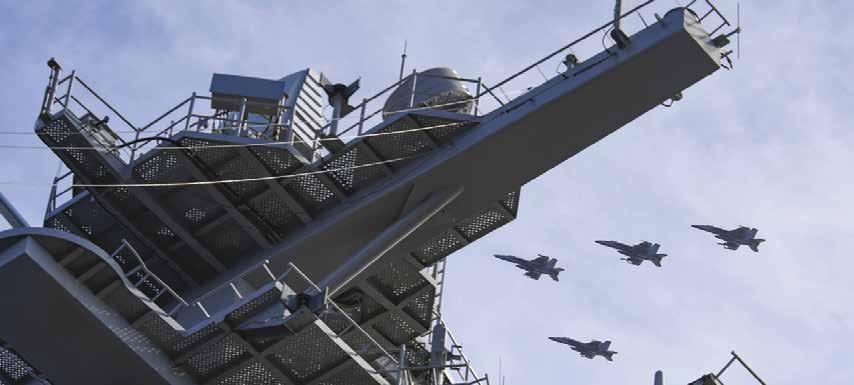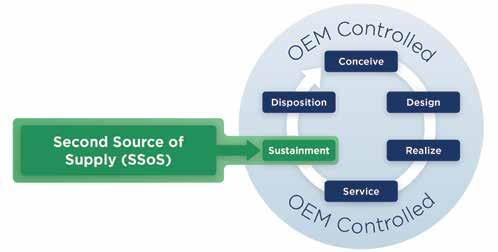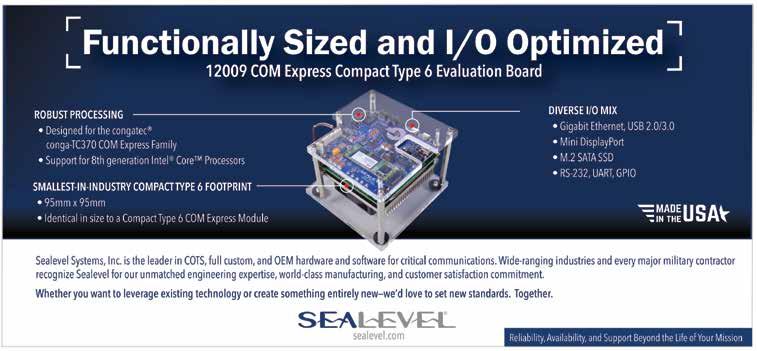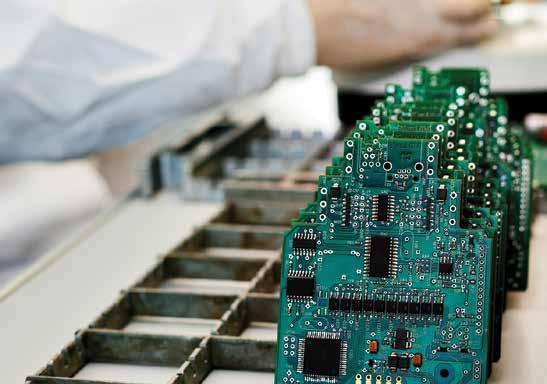
11 minute read
Combat Obsolescence with a Second Source of Supply
by RTC Media
By Ethan Plotkin and Siku Thompson, GDCA, Inc., Livermore, CA
Dismantling Electronic Obsolescence for Defense Programs
Obsolescence is officially recognized by the US Department of Defense (DoD) as diminishing manufacturing sources and material shortages (DMSMS), or “the loss or impending loss of manufacturers of items or suppliers of items or raw materials.” Proactive management in all phases of a life cycle is crucial to avoid costly component replacements, ensure critical weapons system readiness, and reduce risks to warfighters.
It is imperative to go beyond conventional obsolescence management and reverse engineering techniques to create replacement circuit card assemblies (CCAs). Instead, target the supply chain at the root where the original product design was initially introduced by the original equipment manufacturer (OEM).
Legacy equipment manufacturers (LEMs) have established relationships with original equipment manufacturers (OEMs) as an alternative source that reestablishes the manufacturing capability for obsolete commercial off-the-shelf (COTS) and custom CCAs whose supply chains have been broken by electronics obsolescence.
Supported by legal agreements that protect OEMs, a second source of supply (SSOS) is a program that reestablishes the manufacturing capability to support production of parts with older product designs that have fragile supply chains. The SSOSs also include part sustainment plans that ensure a supply of qualified parts for as long as they are needed.
An SSOS for obsolete CCAs is a valid option if:
• the life cycle demand period of your program extends longer than the OEM is able to support it; and
• a life-of-type buy for an end-of-life (EOL) part will not be of sufficient supply to fulfill the lifetime requirements of the program.
The Waterfall Effect
The Unexpected Impact of Electronics Innovation Technology continually pushes the envelope of innovation to the detriment of long-life cycle systems whose designs must be frozen in time to avoid costly systems redesigns. Long life cycle systems are designed to have parts that are required to perform the same function reliably, year after year. Once parts for these systems are no longer in active production, time and money must be spent to maintain and support the system’s longevity. At this stage they are commonly referred to as legacy or sustainment-dominated electronics systems.

New technology pushes old technology out of production, making long-life cycle legacy systems extremely vulnerable to part obsolescence. Maintaining a system whose parts are no longer being manufactured is incredibly challenging. The situation is further complicated by long design cycles that experience electronic component obsolescence in which parts drop out of the supply chain even before a system’s design is completed.
For weapon systems with electronicsintensive systems and even longer design cycles, the sustainment operations and product support costs are higher than the original procurement cost. They also represent the major portion of the system’s total cost of ownership (TCO). When considering the entire system, related equipment, and replaceable assemblies, individual parts and components must be supported until the program is decommissioned or upgraded. Therefore, it’s easy to understand the potential cascading cost and side effects associated with sustaining a legacy system. In rarer and more troubling cases, some programs extend decades beyond the originally forecasted retirement and dismantle date.
Why Parts Go Out of Production: Supply Chain’s Struggle
When updated versions of electronics components are introduced and older versions become obsolete (e.g., microprocessors and computer memory), OEMs are forced to upgrade the CCAs (circuit card assemblies) whose designs use those old parts, even though customers are perfectly happy with the performance of their current version.
When manufacturers cease production of those older CCA designs, EOL notices that offer life-of-type buys (LTBs) often go out to customers, but defense program teams don’t have enough time to respond and adequately fund total life-cycle requirements. Later attempts to reverse engineer CCAs or upgrade current designs are hampered by the costs of rigid design control requirements (e.g., stringent qualifications and recertific ations) that are time consuming and can decimate both a program’s readiness level and budget.
In the face of budget shortfalls, long funding lead times, inventory shortages, and the rapid evolution of technology, programs often find themselves out of sync with rapidly accelerating commercial markets and scrambling to find the parts they need to achieve operational readiness. LEMs (legacy equipment manufacturers), with the capability to offer a second source of supply (SSOS) can help programs stay synchronized with commercial markets and avoid the costs of upgrading until absolutely necessary.
Sourcing: Second Source of Supply As a Qualified Option
Why Old Parts Are So Special Launching and supporting a new program is completely different than managing the ongoing effectiveness of a defense system as it ages. Military, avionics, and naval markets are unlike the commercial markets that can perform technology upgrades and refreshes more readily than defense programs. The lower frequency of design updates in the defense sector leads to increased problems associated with obsolescence, and those problems impact missioncritical systems.
Program managers (PMs) need long-term sustainment planning and ongoing access to critical parts to fend off obsolescence and control total life-cycle systems management (TLCSM) costs. The TLCSM accounts for implementation, management, and oversight by the PM (life-cycle manager) of all activities associated with a systems life cycle. Those activities include all sustainment protocols that aim to ensure life-cycle sustainment and readiness outcomes to improve system operational effectiveness (SOE) for the war fighter techniques outlined in the DoD’s SD22 guidebook (“Diminishing Manufacturing Sources and Materials Shortages: A Guidebook of Best Practices for Implementing a Robust
DMSMS Management Program”), representing traditional best practices to proactively manage CCA obsolescence.
Unfortunately, these practices often fall short when supporting aging programs that require long-term, ongoing access to COTS parts that have proprietary technical data—the kind of intellectual property (IP) data that resides in complex electronic units that are essential to larger systems. COTS parts inherently present unknowable and unpredictable sustainment cost factors that jeopardize a program’s ability to stay aligned with TLCSM road maps, aking it nearly impossible to integrate a robust DMSMS management plan.
Nearly every military weapons system contains COTS CCAs.

Supply Chain Dominance: The Competition for Parts
In order to compete successfully, OEMs of COTS and custom CCAs must introduce new technology in product road maps, inadvertently leaving behind a small number of customers, including defense programs, that rely on a steady supply of older model parts. When COTS parts reach their EOL, the remaining inventory within the open market or supply chain is quickly consumed by the more agile commercial industry customers.
As technology ages, it’s difficult to control the supply chain and retain reliable sourcing of all parts. COTS and custom board manufacturers are generally resistant to prioritizing older, low-volume products over new product introductions and higher revenue. That strategy results in defense programs’ loss of control of the COTS supply chain, control that is required for a strategic sustainment approach.
Supply Chain Dominance: The Competition for Parts
In order to compete successfully, OEMs of COTS and custom CCAs must introduce new technology in product road maps, inadvertently leaving behind a small number of customers, including defense programs, that rely on a steady supply of older model parts. When COTS parts reach their EOL, the remaining inventory within the open market or supply chain is quickly consumed by the more agile commercial industry customers.
Market competition will continue to be a critical forecast element in fluctuating sustainment cost for programs.
Dealing with a Shrinking Availability Window
Delaying the inevitability of obsolescence can sometimes be accomplished with a lifeof-type buy, but programs are often unable to purchase enough parts because the use and growth of weapons systems are unpredictable. When a program can achieve timely funding for an LTB, it’s not unusual for inventory to sit on shelves for decades, only to be scrapped years later.
This cycle of reactive scrambling to forecast and fund LTBs is a chronic occurrence for PMs because COTS components an reach EOL at disturbingly fast and volatile rates.
Automotive, industrial, and other aggressive sectors compete vigorously for leftover COTS parts after they reach EOL. The result is that, even if you plan well and reserve funding for a proactive LTB, if you need more, those items may not be available due to the deterioration of the supply chain.
A New Way to Rebuild the Supply Chain
IWhen looking to the aftermarket, it’s difficult to reverse engineer highly technical military or avionics electronics, let alone reconstruct the manufacturing process. OEM mergers and acquisitions (resulting in product discontinuation), employee attrition, and the passing of time cause a situation in which availability of required schematics, test equipment, pick-and-place machine programs, and numerous other critical elements to rebuild production capability are not assured.
Figure 2: Unlike the consumer electronics sector, sustainment-dominated equipment sectors must prepare for a total cost of ownership for decades (20–50 years). However, extending the availability of existing technology over several decades is only possible if you have complete control over the entire supply chain.
Source: Optimum technology insertion into systems based on the assessment of viability, P. Sandborn.
Technical data have many facets and layers, many of which are proprietary. Understandably, OEMs closely guard their IP to avoid losing hard-fought advantages in a competitive marketplace.
But LEMs (legacy equipment manufacturers) are not driven by new product introduction; instead, they focus only on sustainment. They present an innovative alternative solution that is a natural evolutionary step in the electronics industry’s quest to bridge sustainment problems driven by OEM product discontinuation and the impact electronic obsolescence has on defense programs with sustainmentdominated systems. This bridge, supported by LEMs, allows PMs to integrate a cost-effective and proactive sustainment solution that meets program mandates to improve system operational effectiveness (SOE). A second source of supply (SSOS) is a hybrid DMSMS solution that uses collaboration with OEMs to obtain access to technical data and collaboration with PMs to integrate sustainment parts plans that will restart the production line and deliver qualified parts, effectively fixing/freezing the supply chain of ny given CCA.
Mission Impossible: Obsolescence Management
The concept of obsolescence management has spurred the creation of DMSMS and obsolescence management programs rooted in the belief that obsolescence is an issue that can be solved. But obsolescence is not an issue that can be solved. Obsolescence is an inevitable eventuality, and many of the “solutions” employed by PMs today deliver urgent stop-gap measures that address only the high priority problem parts reports (PPRs) for CCAs. This approach temporarily provides relief for critical readiness issues but does nothing to address future demand requirements. This style of management ensures a future in which the exact same CCA will again need another DMSMS solution until a forced system redesign is the only viable sustainment option. This reactive scenario carries a high price tag and is a driving factor in increased total cost of ownership (TCO).
One of the main reasons programs continue to focus on mitigation strategies instead of implementing lasting parts sustainment solutions that actually meet their lifetime requirements is the complexity of demand forecasting. Without knowing at the beginning of a program exactly how many parts will be needed to support a system to the end of its program, a lasting solution seems out of reach. When those complexities are compounded with funding uncertainties, effective sustainment solutions remain obscure, and trying to resolve parts obsolescence issues entirely can seem like an exercise in futility.
The LEM’s unique position and focus allows them to understand that demand forecasting and funding, as well as production capability, are all only aspects of a successful SSOS effort. With the appropriate strategic engagement* an SSOS program can serve both the TLCSMand performance-based life cycle.

Mission Possible: Parts Sustainment Solutions
An SSOS provides a reliable method of extending the life of electronic assemblies that are used in complex defense and avionics systems.
THE BENEFITS OF SSOS:
• Significantly extends the life of electronics beyond the manufacturer’s end-of-life notice
• Reestablishes or continues the manufacturing production of CCAs
• More effective than other aftermarket
DMSMS solution options: reverse engineering, technology refresh
• Eliminates the scrambling, risk, and lead time usually needed to source genuine (i.e., not counterfeit) parts
• Assures system readiness via a predictable, secure production cycle and supply chain
• Eliminates the need to fund unplanned, obsolescence-forced technology refreshes
Based on an accurate understanding of DMSMS and obsolescence risk, the SSOS establishes programs that deliver parts/ product availability and life cycle sustainment plans as opposed to continuously reacting to obsolescence-driven DMSMS issues with short-term fixes..

Re-Production: Second Source of Supply (SSOS)
An SSOS reestablishes manufacturing capability for obsolete CCAs. It is a cost- finally, reengineer the CCA’s manufacturing capability. The SSOS process delivers all the information necessary to maintain the production supply chain for obsolete CCAs. Moreover, the production capability is designed and maintained to meet the program’s life-cycle requirements as described in an integrated parts sustainment plan. costs are easily identified and anticipated. Finally, there is no requirement to commit to future production volumes.
Deliverables: A Comprehensive Sustainment Solution

An LEM uses questionnaires and meetings to capture the information needed to fully understand the program requirements, forecasts, and scope of required sustainment effort.
Armed with that information, the LEM develops an SSOS proposal that maps out the reengineering efforts and sustainment of manufacturing capability to provide transparent sustainment cost and lead times for qualified parts. By working with the OEM to verify functional compliance and with prime contractors to requalify the supplier, an SSOS allows the program to essentially “fix” the supply chain.
The SSOS proposal not only should include fixed pricing for establishing manufacturing capability and options to ensure the ongoing availability of the CCAs and electronics assemblies to meet program demands, it also should be fundable and flexible enough to account for shifts in demand.
effective approach that fulfills ongoing program requirements and ensures that older designs remain available for as long as they are needed.
How it Works
IBy developing ongoing relationships with suppliers, the LEM ensures long-term availability of the CCA for the customer while supporting the OEM supplier’s strategic objectives and desire to support the customer.
The LEM collaborates with the OEMs, the program, and the prime contractor to protect and transfer the technical data or IP, establish a parts sustainment plan and,
Affordable Readiness
Typically, an SSOS proactive solution is less expensive and faster to implement than traditional reverse engineering alternatives. An SSOS strategic solution offers programs a predictable fixed cost for a replacement CCA for the life of the program, without interruption.
The nonrecurring engineering (NRE) ssociated with an SSOS is also less complicated and poses a lower risk to quality. Thus, an SSOS not only reduces future costs but makes those costs more transparent.
The CCA does not deviate from OEM specifications, and future CCA sustainment
Loaning reference CCAs to those who support the larger assembly (often the prime) enables verification/certification that the new LEM-manufactured cards are fit for their purpose.
Engaging the SSOS Solution
Determining whether your program can benefit from an SSOS solution typically takes six to eight weeks and includes the gathering of qualifying information and stakeholder collaboration. If it is determined that a form, fit, functionally equivalent, remanufactured CCA is a feasible sustainment solution, the program may decide to have an LEM proceed to develop a comprehensive SSOS proposal.
program options that might improve SOE, is recommended.
Conclusion
The COTS and custom CCA sustainment solutions require a comprehensive approach driven by a reliable team of DMSMSexperienced electronic industry professionals who can bring together the available supply chain and OEM resources to deliver sustainment options to PMs that provide life-cycle sustainment assurance with costs that are knowable.

SSOS can be compared to an extended assurance policy purchased to supplement the factory warranty once it has expired and the OEM ceases parts production. In many situations, SSOS is cheaper, faster, and less risky than traditional alternatives.
Lead times for an SSOS proposal vary between six to twelve weeks, depending on the state of the technical data and the health of the supply chain that supports the CCA.
Implementing SSOS for COTS and custom CCAs typically requires some level of NRE (nonrecurring-engineering) to reestablish manufacturing capability and is offset by cost savings of the alternatives, such as avoiding or reducing expensive recertifications.

Therefore, programs are strongly advised to assess SSOS in the context of a side-byside business case analysis of all available DMSMS solution options. Working with an LEM that offers BCA support services, including an economic evaluation of potential










